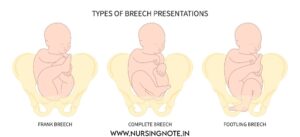Definition of Breech Presentation:
Breech presentation is a fetal position during childbirth where the baby’s buttocks, feet, or both are positioned to emerge first, instead of the head.
In breech presentation, the lie is longitudinal and the podalic pole presents at the pelvic brim. It is the
most common malpresentation.
 |
| Breech Presentations |
Types of Breech Presentation
There are two varieties of breech presentation:
- Complete
- Incomplete
1. Complete Breech (Flexed Breech):
In a complete breech, the fetus maintains the normal attitude of full flexion.
- Position: Thighs are flexed at the hips, and legs are flexed at the knees.
- Presenting Part: Two buttocks, external genitalia, and both feet present at the birth canal.
- Prevalence: This type is more common in multiparous women (those who have had previous deliveries), with an occurrence of about 10%.
2. Incomplete Breech:
An incomplete breech results from varying degrees of extension of the thighs or legs at the fetal pole. This type includes three distinct varieties:
A.Frank Breech:
- Position: Thighs are flexed on the trunk, while legs are extended at the knee joints.
- Presenting Part: Two buttocks and external genitalia only (without the feet).
- Prevalence: The most common form of breech, especially in first-time pregnancies (primigravidae), accounting for around 70%. This is attributed to the firmer abdominal wall and higher uterine tone in primigravida, facilitating early engagement of the breech.
B. Footling Presentation:
- Position: Both thighs and legs are partially extended, causing one or both feet to present at the birth canal.
- Prevalence: Occurs in about 25% of breech presentations. Footling breech poses a higher risk for complications such as cord prolapse.
C. Knee Presentation:
- Position: Thighs are extended, but knees are flexed, causing the knees to present at the birth canal.
- Prevalence: This is the least common form of breech presentation
Etiology of Breech Presentation
- Prematurity: The most common cause, as the fetus may not have had time to turn head-down.
- Breech with Extended Legs: Extended legs make it difficult for the fetus to rotate.
- Twins: Limited space in multiple pregnancies restricts fetal movement.
- Oligohydramnios: Low amniotic fluid reduces fetal mobility.
- Congenital Uterine Abnormalities: Abnormalities such as a septate or bicornuate uterus restrict fetal movement.
- Short Umbilical Cord: A short cord limits fetal movement.
- Hydrocephalus: A large fetal head can fit better in the wide fundal area of the uterus.
- Placenta Previa: A low-lying placenta blocks the fetus from turning head-down.
- Contracted Pelvis: A smaller pelvic opening restricts fetal rotation.
- Hydramnios: Excessive amniotic fluid allows more fetal movement.
- Multiparity: Lax abdominal walls in women who have had multiple pregnancies increase fetal mobility.
- Genetic Conditions: Trisomies (13, 18, 21) can affect fetal muscle tone.
Diagnosis of Breech Presentation
A. Clinical Diagnosis:
Abdominal Palpation: Through Leopold’s maneuvers, the healthcare provider may detect the fetal head at the upper part of the uterus (fundus) and the buttocks or feet near the pelvic inlet.
Vaginal Examination: If labor has begun, a vaginal exam may reveal the fetal buttocks, feet, or genitalia as the presenting part instead of the head.
Auscultation: The fetal heartbeat is often heard above the mother’s umbilicus in breech presentation, rather than lower in the pelvis, as is typical in head-down (cephalic) presentations.
Vaginal Examination: If labor has begun, a vaginal exam may reveal the fetal buttocks, feet, or genitalia as the presenting part instead of the head.
Auscultation: The fetal heartbeat is often heard above the mother’s umbilicus in breech presentation, rather than lower in the pelvis, as is typical in head-down (cephalic) presentations.
B. Sonography (Ultrasound):
Confirms the fetal position, assesses factors like amniotic fluid, placental location, and potential fetal abnormalities related to breech presentation.
Mechanism of Labor in Breech Presentation
In breech delivery, the primary movements occur in sequence for the buttocks, shoulders, and head:
A. Buttocks:
- Engagement: The buttocks engage in an oblique diameter of the pelvic inlet, with the bitrochanteric diameter (10 cm) leading.
- Descent: The buttocks descend until the anterior buttock reaches the pelvic floor.
- Internal Rotation: The anterior buttock rotates behind the symphysis pubis.
- Further Descent and Lateral Flexion: The anterior hip passes under the symphysis pubis, followed by the posterior hip, allowing trunk and lower limbs to deliver.
- Restitution: The buttocks rotate back to their original oblique position.
B. Shoulders:
- Engagement: The bisacromial diameter (12 cm) engages in the same oblique diameter as the buttocks.
- Descent and Internal Rotation: Shoulders rotate into the anteroposterior diameter of the pelvic outlet as the trunk externally rotates.
- Delivery: The posterior shoulder emerges first, followed by the anterior shoulder through flexion of the trunk.
- Restitution and External Rotation: The shoulders rotate, aligning the fetal trunk in a dorsoanterior position.
C. Head:
- Engagement: The head engages either in the opposite oblique or transverse diameter, with the suboccipitofrontal diameter (10 cm) leading.
- Descent with Flexion: The head descends with increasing flexion.
- Internal Rotation: The occiput rotates anteriorly, positioning behind the symphysis pubis.
- Descent and Flexion for Delivery: The subocciput hinges under the symphysis pubis, and the head delivers by flexion, with the chin, mouth, nose, forehead, and occiput appearing successively.
- Expulsion: Expulsion of the head relies on maternal bearing-down efforts, not on uterine contractions.
FAQs Section
- The Most Frequently Asked Question related Breech Presentation are:
- Q1: What is the most common type of breech presentation?
A1: The frank breech is the most common, occurring in about 70% of cases. - Q2: What are the risks of breech delivery?
A2: Risks include cord prolapse, head entrapment, and delivery complications.
- Q1: What is the most common type of breech presentation?
